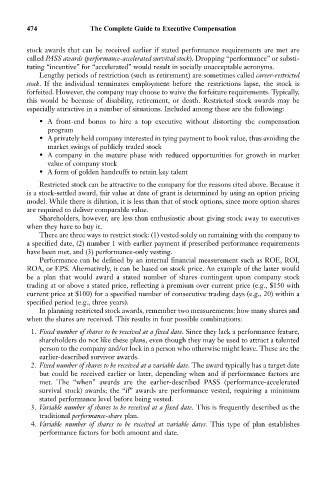Page 488 - Bruce Ellig - The Complete Guide to Executive Compensation (2007)
P. 488
474 The Complete Guide to Executive Compensation
stock awards that can be received earlier if stated performance requirements are met are
called PASS awards (performance-accelerated survival stock). Dropping “performance” or substi-
tuting “incentive” for “accelerated” would result in socially unacceptable acronyms.
Lengthy periods of restriction (such as retirement) are sometimes called career-restricted
stock. If the individual terminates employment before the restrictions lapse, the stock is
forfeited. However, the company may choose to waive the forfeiture requirements. Typically,
this would be because of disability, retirement, or death. Restricted stock awards may be
especially attractive in a number of situations. Included among these are the following:
• A front-end bonus to hire a top executive without distorting the compensation
program
• A privately held company interested in tying payment to book value, thus avoiding the
market swings of publicly traded stock
• A company in the mature phase with reduced opportunities for growth in market
value of company stock
• A form of golden handcuffs to retain key talent
Restricted stock can be attractive to the company for the reasons cited above. Because it
is a stock-settled award, fair value at date of grant is determined by using an option pricing
model. While there is dilution, it is less than that of stock options, since more option shares
are required to deliver comparable value.
Shareholders, however, are less than enthusiastic about giving stock away to executives
when they have to buy it.
There are three ways to restrict stock: (1) vested solely on remaining with the company to
a specified date, (2) number 1 with earlier payment if prescribed performance requirements
have been met, and (3) performance-only vesting.
Performance can be defined by an internal financial measurement such as ROE, ROI,
ROA, or EPS. Alternatively, it can be based on stock price. An example of the latter would
be a plan that would award a stated number of shares contingent upon company stock
trading at or above a stated price, reflecting a premium over current price (e.g., $150 with
current price at $100) for a specified number of consecutive trading days (e.g., 20) within a
specified period (e.g., three years).
In planning restricted stock awards, remember two measurements: how many shares and
when the shares are received. This results in four possible combinations:
1. Fixed number of shares to be received at a fixed date. Since they lack a performance feature,
shareholders do not like these plans, even though they may be used to attract a talented
person to the company and/or lock in a person who otherwise might leave. These are the
earlier-described survivor awards.
2. Fixed number of shares to be received at a variable date. The award typically has a target date
but could be received earlier or later, depending when and if performance factors are
met. The “when” awards are the earlier-described PASS (performance-accelerated
survival stock) awards; the “if” awards are performance vested, requiring a minimum
stated performance level before being vested.
3. Variable number of shares to be received at a fixed date. This is frequently described as the
traditional performance-share plan.
4. Variable number of shares to be received at variable dates. This type of plan establishes
performance factors for both amount and date.

